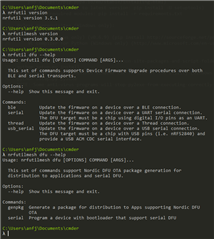I see there is a serial bootloader dfu example, however I am unable to find an OTA Mesh DFU example.
How can I exercise the Mesh DFU OTA (not via serial connection) in side-by-side mode?
Is the DFU quick start guide in the info center supposed to use a usb-serial device (nRF52 PCA11040 in my case) to actually issue the Mesh OTA update to a non-serial device? It looks like that may be the case, but it isn't clear to me.
Also, the instructions provided by DFU quick start guide in the info center for nrfutil seem to be incorrect, as I get the following errors for the various commands:
Error: no such option: --company-id
Error: No such command "genpkg".
Error: no such option: --mesh
In the end, I need to OTA update devices in a mesh network. My device issuing the update will be a linux iot gateway on the mesh network.
I'm looking for a nordic example to use as a basis for that development (and to test the mesh bootloader on my devices).
A python script, C-code, flow chart, etc would be useful.
Thanks!

